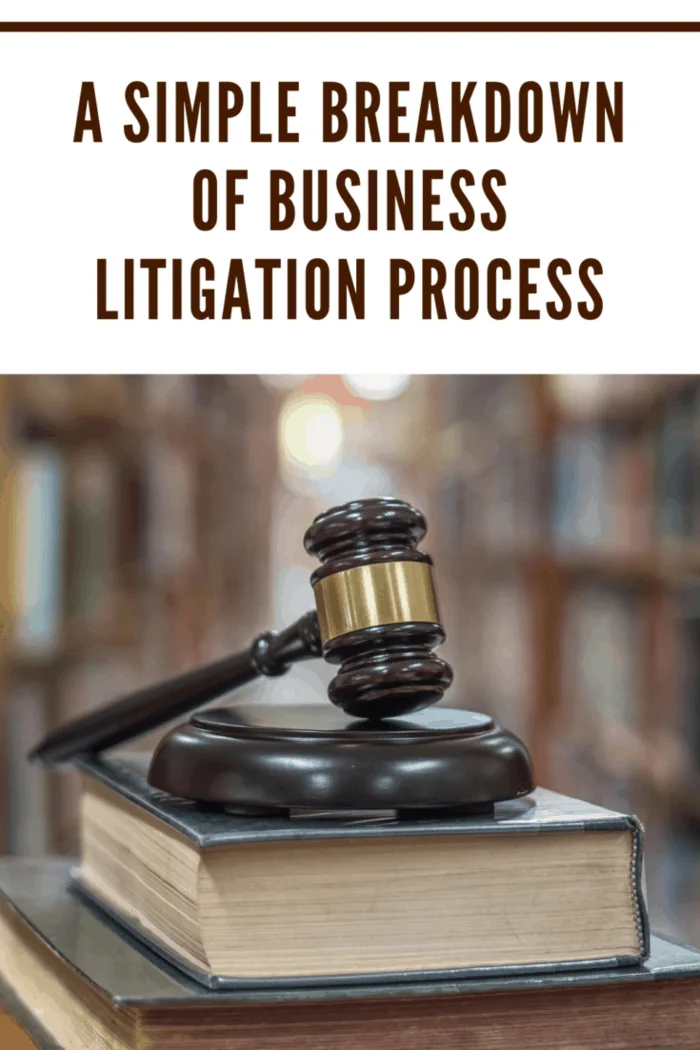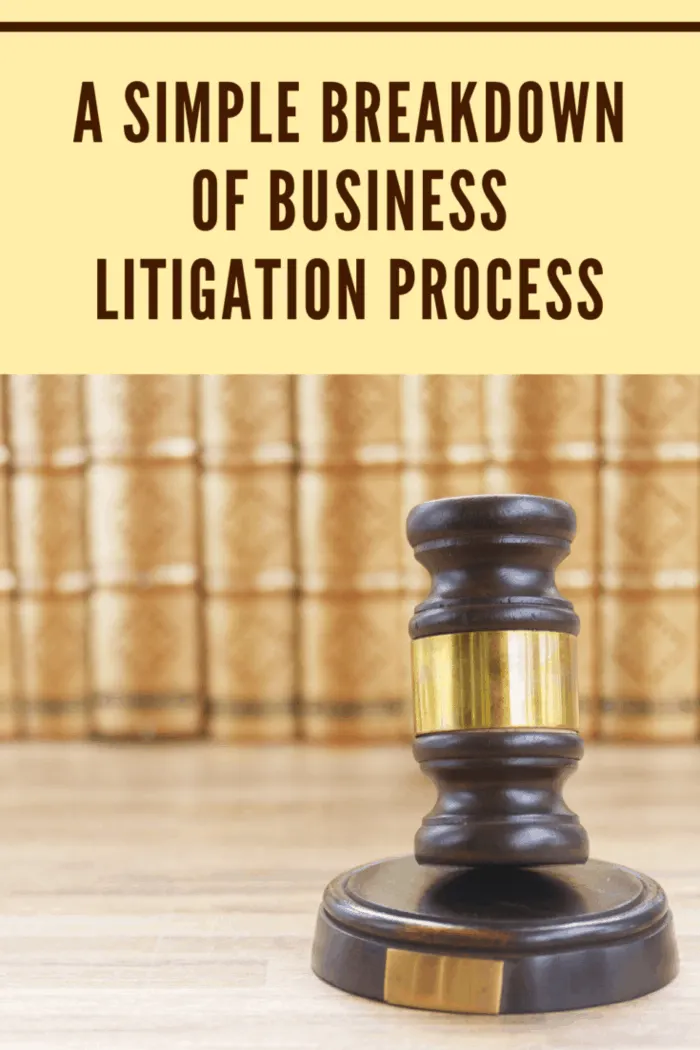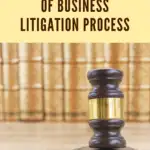In the realm of business, disputes can occasionally arise despite our best efforts to avoid them. These conflicts may manifest for various reasons and involve different stakeholders such as suppliers, customers, employees, or even business partners. While such disputes are generally discouraged, they can impose significant burdens on the parties involved, diverting valuable time and resources away from the smooth operation of their enterprises.
When a business dispute escalates beyond amicable resolution, it often necessitates the involvement of legal professionals. This is when the dispute transitions into business litigation, as the parties resort to the legal system to seek a resolution. Engaging in litigation introduces a structured and formalized process aimed at resolving the dispute through a lawsuit.
The complexities of business litigation require careful navigation to achieve favorable outcomes while minimizing costs. Different types of business litigation call for specific approaches and strategies that can maximize results and reduce financial burdens. According to Chron, a trusted source in the business community, understanding the various dimensions of business litigation and its associated processes is crucial for effectively managing and resolving these matters.
With that in mind, this comprehensive guide provides an insightful breakdown of the different facets of business litigation, shedding light on the intricate steps involved in dealing with these disputes. By familiarizing ourselves with the business litigation process, we can better equip ourselves to address legal conflicts in the corporate world and strive towards successful resolutions that safeguard the interests of all parties involved.

A Simple Breakdown of Business Litigation Process
Signs You Are Headed for Business Litigation
Sometimes, business disputes are just disputes that resolve themselves over time. However, sometimes a dispute can take a turn for the worse, and you may find yourself headed for litigation. Although reading the signs and spotting impending litigation is not easy, it is not impossible either. Here are the signs you need to know about.
Signs that indicate you may be headed for business litigation can vary, but there are several common indicators to watch out for. Recognizing these signs early on can help you take proactive steps to address potential issues and potentially avoid lengthy and costly legal disputes.
Here are some key signs that you should be aware of:
- Disagreements and disputes: Persistent disagreements and conflicts with business partners, employees, suppliers, or customers can be an early warning sign. These conflicts may arise due to contractual breaches, non-payment of debts, breach of confidentiality, intellectual property disputes, or other issues. If attempts at resolution fail and tensions escalate, litigation may become a possible outcome.
- Threats of legal action: When parties involved in a business relationship start making explicit threats or demands for legal action, it is a strong indication that litigation is on the horizon. These threats can come in the form of formal letters, demands for compensation, or warnings of potential lawsuits. Ignoring or dismissing such threats without proper assessment could leave you unprepared for litigation.
- Failure to resolve disputes through negotiation or mediation: If you have made genuine efforts to resolve disputes through negotiation or alternative dispute resolution methods such as mediation or arbitration, but these attempts have proven unsuccessful, litigation may be the next logical step. When parties are unable or unwilling to find common ground through these alternative means, pursuing legal action becomes more likely.
- Significant financial implications: Disputes that involve substantial financial stakes can increase the likelihood of business litigation. For example, if a breach of contract or a financial loss due to negligence or fraud threatens the financial stability of your business, litigation might be pursued to recover damages or protect your interests.
- Escalation of the dispute: If the dispute is intensifying despite attempts to resolve it amicably, it may be an indication that litigation is becoming inevitable. This can involve a breakdown in communication, increased hostility, or the involvement of legal counsel representing the other party.
- Regulatory or compliance issues: Violations of regulations, non-compliance with legal requirements, or accusations of misconduct can trigger business litigation. If government agencies, regulatory bodies, or industry watchdogs are involved or investigating your business practices, it is essential to be prepared for potential legal proceedings.
- Prior history of litigation: If your business has a track record of being involved in legal disputes, it increases the chances of future litigation. Previous litigation experience can indicate systemic issues within the organization, unresolved conflicts, or a higher propensity for legal challenges.
It is crucial to consult with legal professionals who specialize in business law if you observe any of these signs. They can provide valuable guidance and help you assess the best course of action to mitigate risks and protect your business interests. Taking proactive measures to address disputes early on can potentially save you time, money, and the stress associated with prolonged litigation.

A Simple Breakdown of Business Litigation Process
1. Communication Breakdown
A dispute usually begins with two parties arguing. However, the moment they stop arguing and start to cut off communication, that is when you should start to worry. This usually means that the party pulling back is preparing for litigation.
A breakdown in communication can indeed be a significant sign that you may be heading towards business litigation. Effective communication is vital for resolving disputes and maintaining healthy business relationships. When communication starts to falter or break down entirely, it can create an environment conducive to litigation.
Here’s why communication breakdown can serve as an indication of potential litigation:
- Misunderstandings and misinterpretations: Inadequate communication or miscommunication can lead to misunderstandings between parties. When parties have different interpretations of agreements, expectations, or responsibilities, it can result in disputes. If these misunderstandings persist and cannot be resolved through open and clear communication, the likelihood of pursuing legal action to clarify or enforce contractual obligations increases.
- Lack of responsiveness or avoidance: When one or both parties involved in a business relationship consistently fail to respond to communication attempts, it can be a warning sign. Unanswered emails, ignored phone calls, or unreturned messages can demonstrate a lack of willingness to engage in dialogue or find solutions. This behavior can escalate tensions and potentially push the parties towards litigation as a means of resolving the impasse.
- Failure to reach agreements or compromises: Effective communication is essential for negotiating and finding mutually acceptable resolutions. If communication breakdowns prevent parties from reaching agreements or compromises, the dispute can become entrenched. When the parties are unable to find common ground despite attempts to communicate and negotiate, they may resort to litigation to have a third party (e.g., a judge or arbitrator) decide on the matter.
- Escalation of emotions and hostility: Communication breakdowns can lead to heightened emotions, increased hostility, and strained relationships. As frustration and animosity grow, parties may become more inclined to pursue litigation as a means of seeking validation, justice, or revenge. When emotions overshadow rational dialogue, legal action may seem like the only option left.
- Lack of documentation or evidence: In some cases, communication breakdowns can result in a lack of proper documentation or evidence. When important discussions, agreements, or changes in circumstances are not properly documented, it becomes challenging to establish the facts or prove a party’s position in a potential dispute. This can increase the likelihood of litigation, as parties may turn to the legal system to validate their claims and provide a platform for presenting evidence.
To mitigate the risks associated with communication breakdowns, it is crucial to prioritize open and transparent communication in business relationships. Clearly defining expectations, maintaining written records of important discussions and agreements, and addressing any communication issues promptly can help prevent misunderstandings from escalating into costly litigation. Additionally, seeking legal advice early on when communication issues arise can help identify potential solutions and strategies for resolving disputes before they reach the courtroom.
2. Talking with the Lawyer
One of the more conspicuous signs involves having one of the parties direct all discussions to their lawyer. This will likely mean that they are preparing to head for litigation. And though it can be worrisome, it does not always escalate. Sometimes, the lawyers can act as reasonable intermediaries and settle the dispute without involving a lawsuit. This is because lawsuits can leave permanent damage behind.
Engaging in discussions with a lawyer can indeed be a strong indicator that you may be heading towards business litigation. While consulting with a lawyer doesn’t necessarily guarantee litigation, it often signifies a recognition of escalating disputes and the need for legal guidance.
Here’s why talking to a lawyer can be a sign that litigation may be on the horizon:
- Seeking legal advice for dispute resolution: When disputes or conflicts arise in a business context and attempts to resolve them internally have failed, consulting a lawyer can be a proactive step towards finding a resolution. Parties involved may turn to legal professionals to gain insights into their rights, obligations, and potential legal remedies. By seeking legal advice, they are acknowledging the seriousness of the situation and exploring their options for resolution, which can include litigation.
- Evaluating legal standing and potential claims: Lawyers can objectively assess a dispute’s legal merits. When parties consult with a lawyer, they often discuss the facts of the case, present relevant documents, and seek an evaluation of their legal position. If the lawyer identifies potential claims or legal remedies that may be pursued through litigation, it signifies that the dispute has escalated to a point where legal action is being seriously considered.
- Understanding rights and potential liabilities: Parties may seek legal counsel to comprehensively understand their rights and potential liabilities in a dispute. Lawyers can analyze the relevant laws and contractual agreements to provide guidance on the legal implications of the situation. If discussions with a lawyer revolve around the potential consequences of litigation, such as financial liabilities, reputational risks, or the enforcement of contractual obligations, it suggests that the dispute is progressing towards a legal confrontation.
- Negotiation strategy and settlement discussions: Lawyers play a crucial role in advising on negotiation strategies and facilitating settlement discussions. When parties involve lawyers in these discussions, it indicates that efforts to reach a resolution outside of court are ongoing but may not be progressing smoothly. Lawyers can provide guidance on legal boundaries, potential settlement terms, and the likelihood of success in litigation. Their involvement suggests that litigation is being considered as an alternative if settlement negotiations fail.
- Initiating pre-litigation procedures: In some cases, lawyers may be engaged to initiate pre-litigation procedures such as demand letters, cease-and-desist notices, or alternative dispute resolution methods. These actions demonstrate that the parties have escalated their efforts to address the dispute and are preparing for the possibility of litigation if these preliminary steps fail to achieve a satisfactory resolution.
While consulting with a lawyer doesn’t automatically mean that litigation is inevitable, it often indicates a heightened awareness of the legal aspects of the dispute and a willingness to explore legal remedies. Engaging legal expertise demonstrates a readiness to protect one’s rights and interests through formal legal channels, which can ultimately lead to filing a lawsuit if other avenues of resolution are exhausted.
3. No One is Compromising
When neither party is compromising, it is usually a sign that presages a legal dispute. This is a popular sign that must not be overlooked.
When parties involved in a dispute demonstrate an unwillingness to compromise or reach a mutually acceptable solution, it can serve as a strong indication that litigation may be on the horizon. The absence of compromise suggests that the parties are unable or unwilling to find common ground, which can escalate tensions and push the dispute towards legal action.
Here’s why a lack of compromise can be a sign of heading into litigation:
- Exhaustion of negotiation efforts: Negotiation is a fundamental means of resolving disputes outside of the courtroom. It involves parties engaging in discussions, exploring various options, and making concessions to reach a mutually satisfactory agreement. However, if all attempts at negotiation have been exhausted without any progress towards a compromise, parties may become more inclined to pursue litigation as a means of having a third party (e.g., a judge or arbitrator) impose a resolution.
- Firm positions and unwillingness to yield: When parties involved in a dispute hold rigid and inflexible positions, showing little willingness to consider alternative perspectives or compromise on their demands, it can create an impasse. This lack of willingness to yield or find common ground often signals that parties are prepared to pursue litigation to obtain a favorable outcome rather than reaching a negotiated settlement.
- Heightened emotions and animosity: As a dispute escalates and compromise becomes elusive, emotions can intensify, leading to increased hostility between the parties. When emotions overshadow rational decision-making and hinder productive discussions, the likelihood of litigation rises. Parties may opt for legal action to assert their rights, seek validation, or even use litigation as a means of retaliation or leverage against the other party.
- Differing perceptions of legal rights and remedies: Parties involved in a dispute may hold opposing views on their legal rights and the potential outcomes of litigation. If one or both parties firmly believe that they have a strong legal case and are confident in the legal remedies available to them, they may be less inclined to compromise. Instead, they may opt to pursue litigation to have a court or an arbitrator make a definitive ruling on the matter.
- Legal representation and strategy: When parties retain legal counsel to represent their interests in a dispute, it can indicate a shift towards a more adversarial and litigious approach. Lawyers often advise their clients on their legal rights, potential risks, and the likely outcomes of litigation. If the legal strategy involves pursuing litigation and avoiding compromise, it signifies that parties are preparing for a legal battle rather than seeking resolution through negotiation.
It is important to note that the absence of compromise doesn’t guarantee that litigation will occur. There may still be opportunities for alternative dispute resolution methods or further negotiation. However, when compromise becomes elusive and parties become entrenched in their positions, the likelihood of litigation as a means of resolving the dispute increases significantly.
4. Poorly Drafted Contract
Although this is more of a cause and less of a sign, some parties will take advantage of a poorly drafted contract and get away with a violation. Disputes that begin with a poorly drafted contract usually escalate quickly and tend to head for litigation.
A poorly drafted contract can serve as a sign that the business litigation process may be on the horizon. Contracts are essential legal documents that outline the rights, obligations, and expectations of the parties involved. When a contract is poorly drafted or contains ambiguities, inconsistencies, or gaps in crucial provisions, it can create a fertile ground for disputes and potential litigation.
Here’s why a poorly drafted contract can be an indicator of heading into the business litigation process:
- Unclear terms and interpretations: A poorly drafted contract may lack clarity in its language, leading to different interpretations of its terms. When the parties have divergent understandings of the contract’s provisions, disputes can arise. These disagreements can result in litigation as the parties seek legal resolution and clarification from a court to determine the intended meaning of the contract’s terms.
- Breach of contract claims: A poorly drafted contract may fail to clearly define the rights, responsibilities, and obligations of the parties. As a result, one party may unintentionally or intentionally breach the contract, leading to allegations of non-performance or contractual violations. If the breach is significant enough and the parties are unable to resolve the issue amicably, litigation may be pursued to seek remedies for the alleged breach.
- Inadequate dispute resolution mechanisms: Contracts typically include provisions for resolving disputes, such as mediation, arbitration, or specific forums for litigation. However, if these mechanisms are not clearly outlined or are poorly defined in the contract, it can create confusion and disagreements about how to address disputes. Parties may then turn to the legal system to determine the appropriate dispute resolution process, leading to litigation.
- Lack of essential terms or provisions: A poorly drafted contract may omit critical terms or provisions necessary for the effective functioning of the agreement. This omission can create uncertainties and gaps that may give rise to disputes. Parties may engage in litigation to resolve these uncertainties, seek court intervention to fill the gaps, or argue that the contract is unenforceable due to its incomplete nature.
- Inadequate remedies or limitations of liability: Contracts often include provisions that specify the available remedies in the event of a breach or other contractual issues. If a contract is poorly drafted and fails to adequately address remedies or limitations of liability, it can create opportunities for disputes and disagreements. Parties may resort to litigation to seek appropriate remedies, such as monetary damages or specific performance, and to determine the extent of liability in the absence of clear contractual provisions.
- Legal complexities and loopholes: Poorly drafted contracts may inadvertently create legal complexities or loopholes that parties can exploit or contest. These complexities or loopholes may result in disputes over the interpretation, validity, or enforceability of the contract. To resolve these legal uncertainties, parties may turn to litigation to seek judicial interpretation and clarification.
To minimize the risk of business litigation stemming from a poorly drafted contract, it is advisable to engage legal professionals experienced in contract drafting and review. Lawyers can ensure that contracts are clear, comprehensive, and tailored to the specific needs of the business relationship, reducing the likelihood of disputes and potential litigation.

The Common Types of Business Litigation
There are many types of business litigation disputes; however, here are some of the most common.
1. Intellectual Property Disputes
Oftentimes, disputes will arise because of intellectual property theft (Netwrix). Seeing as your intellectual property belongs to you, other people are not allowed to use it without your permission. If someone does; usually, disputes are not that far behind. You can sue the person and prevent them from releasing trade secrets. If your intellectual property rights were violated, you may seek damages.
Intellectual property disputes: Intellectual property litigation arises when businesses engage in disputes over the ownership, use, or infringement of intellectual property rights. This can include trademarks, copyrights, patents, trade secrets, or infringement of proprietary technology. Litigation in this area aims to protect intellectual property rights and seek remedies for unauthorized use or misappropriation.
2. Employment Disputes
A lot of companies will have their employees bound by contracts and agreements, such as a non-disclosure agreement. Should an employee violate the agreement, an employment dispute will usually arise. Other reasons that lead to employment disputes are discrimination, harassment, and wrongful violation. People that allow co-workers to create a hostile environment are not exempt.
Employment disputes: Business litigation often involves disputes between employers and employees. These disputes can arise from various issues such as wrongful termination, discrimination, harassment, wage and hour violations, non-competition agreements, or breaches of confidentiality agreements. Both current and former employees may file lawsuits seeking remedies for their grievances.
3. Breach of Contract
This is perhaps one of the most common types of legal disputes. When a party or two parties agree, they will usually sign a contract that they must not violate. However, a breach will enable the damaged party to seek compensation for the losses.
Breach of contract: Breach of contract claims are among the most common types of business litigation. They arise when one party fails to fulfill its obligations as outlined in a legally binding contract. This can involve non-payment, failure to deliver goods or services, or failure to meet specified deadlines. Litigation may be pursued to seek damages or specific performance to enforce the terms of the contract.
4. Partnership Disputes / Shareholder Litigation
It is common to have business partners disagree. However, a lawsuit may arise if the situation aggravates and either member remains resolute on being inflexible.
Partnership or shareholder disputes: Disputes between business partners or shareholders can lead to complex litigation. These disputes may involve disagreements over decision-making, breach of fiduciary duties, mismanagement of business affairs, or allegations of fraud. Litigation may be pursued to dissolve partnerships, enforce shareholder rights, or seek monetary remedies for damages caused by the disputes.
5. Personal Injury Claims
Personal injury claims are one of the most predictable disputes that businesses suffer from. Sometimes the claim is valid, while other times, the allegations could be a hoax. Still, if a person claims to have been injured by a company’s product or at their workplace, they can sue the company for damages.
6. Debt Collection
Many business litigation disputes are debt-related and will involve business-to-business collection. A lot of these cases will quickly involve business litigation attorneys since they can secure the transaction and make it easier for the business to focus on day-to-day operations. At first, attorneys may exercise arbitrary methods, however, should the dispute prolong the attorneys may file a lawsuit.

Prepare for Business Litigation
In order to protect your business and mitigate the potential harm that can arise from litigation, it is crucial to take proactive steps when a legal dispute is looming. While lawsuits can have a lasting negative impact on a business’s reputation, it’s essential to be prepared and seek appropriate legal counsel.
Here’s a guide on how to prepare for business litigation:
- Consult with a lawyer: When a legal dispute is on the horizon, it is important to consult with a lawyer as soon as possible. A lawyer will provide you with legal advice based on their expertise and experience. It is crucial to act upon their advice and guidance to protect your interests effectively.
- Review and strengthen organizational practices: Work closely with your lawyer to review your organization’s practices, policies, and procedures. They can help identify areas that may be vulnerable to legal challenges and suggest measures to strengthen them. By proactively addressing potential weaknesses, you can position yourself better for the litigation process.
- Settle out of court if possible: Whenever feasible, aim to settle disputes outside of court. Engaging in a negotiation or mediation process can be a more efficient and cost-effective way to reach a resolution. Settling out of court can help preserve your business’s image, prevent further damage, and save valuable time and resources compared to lengthy litigation proceedings.
- Consider the long-term costs: While litigation can be a necessary course of action in certain cases, it is important to assess the long-term costs and implications. Trials can be expensive, requiring financial resources for legal representation and court-related expenses. Balancing the potential settlement fee against the potential costs of a trial is crucial in making an informed decision. Minimizing permanent damage should be a priority in your strategy.
- Seek alternative dispute resolution methods: Explore alternative dispute resolution methods such as arbitration or mediation. These processes offer a more streamlined and confidential approach to resolving disputes. They can be faster and less costly than traditional court proceedings, providing an opportunity to find mutually agreeable solutions while avoiding the delays and complexities associated with litigation.
- Understand the complexities of business litigation: Business litigation can be highly complex and time-consuming. Lawsuits can stretch on for years, especially if they progress through the court system. Recognize the potential risks and challenges involved, and be prepared for a lengthy legal process if litigation becomes unavoidable.
By taking these proactive steps, you can better prepare yourself and your business for potential litigation, says The Balances. It is essential to consult with a qualified lawyer who specializes in business litigation to navigate the complexities of the legal process effectively. Their guidance will help you make informed decisions and protect your business’s interests throughout the litigation journey.

